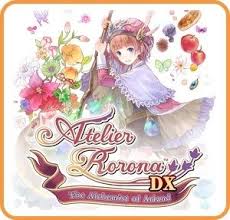I’m a latecomer to the Atelier series. I played dabbled briefly with Atelier Iris 3 back in the day, but it wasn’t until a couple of years ago with Atelier Firis that I really got into Gust’s heartwarming JRPGs. From that perspective, going back to Atelier Rorona—which first came out almost a decade ago—is a journey to a simpler time, for better and worse.
Where recent games have been more plot-focused, Atelier Rorona is more about simply living an alchemist’s life and interacting with the townspeople around you. A broad narrative framework sets up the game cycle—Rorona’s workshop will be closed unless she completes a series of tasks for the kingdom over three years—but within that, the story largely comes from the individual character vignettes that unfold as you get to know the people in Rorona’s life.
In some ways, it’s Atelier in its purest form: a whimsical slice-of-life full of charming characters and plenty of misadventures among friends. With no world in need of saving or scheming villains to thwart, or even so much as a final boss to fight, it’s a welcome reprieve from the usual JRPG tropes. It’s just you and your atelier, and within some restrictions, what you do with your time is mostly up to you.

By extension, Atelier Rorona offers plenty of different “routes”, if you like, and some 14 different endings. Spending time with Arland’s citizens and using your alchemy talents to help them out lets their individual stories unfold, from the Rorona’s childhood friend Cordelia trying to figure out her place in Rorona’s increasingly busy life to the knight Sterk’s conflict with an unscrupulous minister. Other routes come about from reaching certain milestones, like reaching a specific combat level, earning a certain amount of money, or making a load of spectacular pies.
As such, it’d be very difficult to see everything that Atelier Rorona has to offer in a single playthrough, but that’s part of the appeal. This isn’t some sort of contrived “your choices matter!” narrative so much as just a slice of alchemist life, and what you see of that life comes down to how you play. Thankfully, a single playthrough is relatively brief by JRPG standards, making repeat visits to the cheerful village of Arland that much more appealing.

The trade-off to all of this is a fairly strict time limit on everything you do. The game takes place over the span of three in-game years, and almost everything you do advances the clock. Crafting an item takes at least a day; travelling out to the various monster-filled dungeons to collect ingredients takes a few days at minimum, and often longer depending on how long you spend there; resting to restore Rorona’s HP and MP—the latter of which is used for both item creation and combat—takes a day or two at least once every couple of weeks.
What this means is that you have to be careful about what you choose to do with your limited time, lest you waste days and find yourself unable achieve what you want before the clock runs out. The main objectives are a series of 12 assignments from the kingdom, one every three months; achieving at least a passing mark on these isn’t difficult, but carelessness could lead to a game over, and you’ll want to put more time and effort into getting good results if you want the better endings. Meanwhile, juggling the array of different side quests becomes more about time management and priorities than anything else.

I’m in two minds about all of this. On the one hand, there’s a certain satisfaction in achieving things under pressure, and it certainly keeps the whole game ticking along without letting you fall down a rabbit hole of spending hours trying to craft the perfect item. On the other hand, the obsessive completionist in me likes taking the time to complete every quest and craft every item I can along the way, which simply isn’t feasible in Atelier Rorona
The time limit works in the context of the main game, and it’s not so frustrating once you figure out what you’re doing, but I wish there was some sort of unlimited free time after the main story’s all wrapped up. A post-game scenario gives you an extra year after the credits roll, but that isn’t that much extra time, and there’s still a lot you can miss if you don’t put in the necessary work during the main campaign. It’s here, more than anywhere else, that Atelier Rorona feels dated, even with the quality of life improvements that the Plus version (and, by extension, this DX version) brings about.
Where the game hasn’t aged a bit is in the art direction, which is as gorgeous as ever. Atelier Rorona was Mel Kishida’s debut as a character designer, and his style is one of the most enchanting of anyone working in the videogame industry today. His designs are marked by their pastel palettes and and soft line work, giving them an serene, dreamy quality, but there’s always a quiet strength underneath all that. Atelier Rorona makes full use of that with plenty of hand-drawn 2D artwork, and even the 3D models, though technically dated by now, look as beautiful as ever.

I suspect that with the release of Atelier Rorona DX on Switch (along with its sequels, Atelier Totori DX and Atelier Meruru DX), there’ll be a lot of newer Atelier fans getting their first taste of the Arland trilogy. Atelier Rorona DX is a throwback to an older, simpler time in the series’ history, and though some aspects haven’t aged so well, the core of what makes Atelier special—their heartwarming qualities and simple, slice-of-life joys—are at their most pure here.



